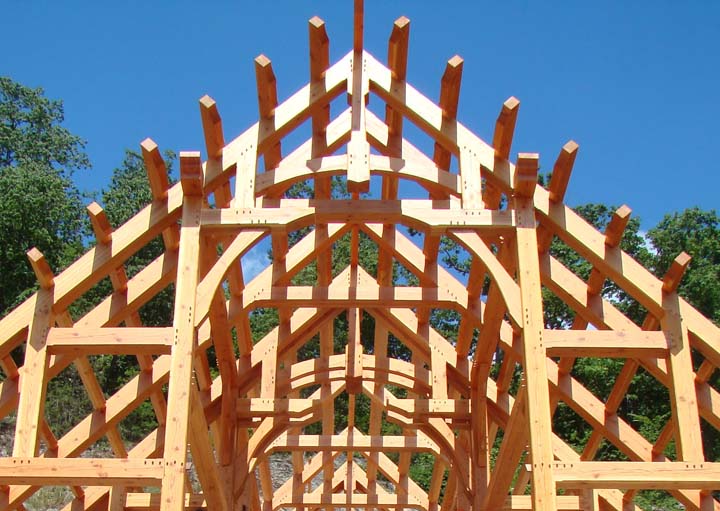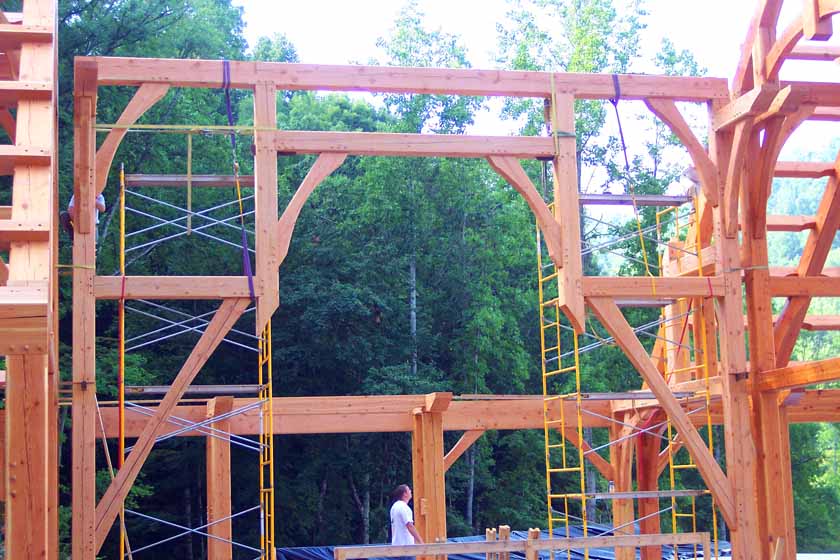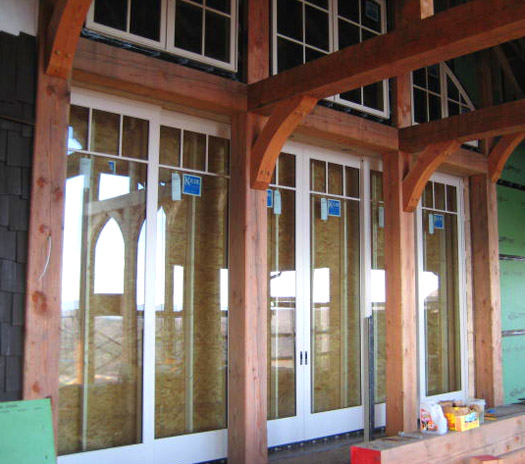Being a Timber Frame Home Architect is a Rewarding Job
Sure, it’s nice to be paid for what you do, but another payoff is the delight you see in your clients’ eyes and voices when they begin to understand what you have designed for and with them: their timber frame home. And a timber frame home is a wonderfully warm and substantial place to have as a house. The sense of permanence and the openness of the structural system in timber frame homes provide qualities that you don’t see or feel in many other residential projects.
(C)Copyright 2010 Rand Soellner, All Rights Reserved Worldwide. Anyone is hereby licensed to Link to this press release with your anchor text on your website of: Timber Frame Home.
Rand Soellner Architect specializes in the design of an individual timber frame home for each and every client that wants one. Some clients end up requesting a hybrid solution, as a real, pure timber frame home costs more to fabricate and build than a conventionally constructed house. Rand Soellner Architect produces what clients request, after they understand the implications of their choices.
What is a Timber Frame Home?
Timber Frame Home Structural Members

A timber frame home is a structural system of posts and beams that forms the primary support of a house. Posts are vertical, sometimes called columns, while beams are horizontal. There are also joists and girders which are also horizontal. Joists are the smallest of wooden horizontal spanning members. In a home, these might range from 6×8’s to 12×12’s. Girders are the largest of horizontal solid spanning members, bigger than beams. Girder support beams. Beams in a timber frame home might range from 6×12’s to 12×14’s. Timber girders in a timber frame home are rare, since finding a straight, solid tree that large is hard. For instance, wanting a girder of say 18’x 36″ would be just about impossible to find, as that would be an absolutely huge tree. That tree would likely be hundreds of years old to get that large, and its hard to find one that have not been harvested yet. It would also be expensive. Expensive to buy the tree, if you could find it, expensive to haul it to the sawmill, because it would weigh tons, and expensive to transport on a flat bed truck on the highway to the project site. Perhaps something like this might still be available out of Douglas Fir in Wyoming or Washington State.
Timber Frame Home Girders and Trusses
A more efficient and less costly way to support loads that a wooden girder might hold would be to use a wooden truss out of smaller members, custom designed for the span; loads and beams and joists framing into or onto it. This would weigh much less too, because it is not entirely solid. A truss, timber or otherwise, works by efficiently separating the top chord of the truss (the top horizontal member) from the bottom chord of the truss (the lower horizontal member) by several inches or feet. This places the top chord in compression and the bottom chord in tension.
Wood is fairly effective at dealing with both of these forces, if properly braced. And this intermittent bracing is provided in the form of struts. These struts are shorter pieces of wood (in a heavy wooden truss) that connect the top chord to the bottom chord. These struts can be vertical and/or diagonal and are normally a combination of the two geometries, whether or not the top chords are flat (horizontal) or sloped (as in the case of a roof plane). Metal, typically higher strength steel plates and bolts can be used to secure the struts to the chords, or in a pure timber frame truss, most timber plants prefer to use the time-honored wooden peg connections, glued and hammered through bore holes made through mortise and tenon connections where each strut meets each chord.
Timber Frame Home Mortise and Tenon Connections

It so happens that the above described mortise and tenon with pegs connection is also the primary method of connecting posts to beams in a timber frame home. Also, in a timber residence, there are often diagonal braces of smaller timbers, usually at a 45 degree angle, strengthening the post-to-beam joint. You can see these in the photo to the side here. These smaller timber braces are generally provided at key locations to brace the frame of timbers (hence the term “timber frame”) against wind and other structural forces, such as possible earthquake lateral movement. The fact that this type of timber frame bracing was used on ocean-going sailing ships made of wood is testimony to the types of lateral and racking forces that this diagonal bracing joint is capable of handling. If a very heavy, tall sailing ship with scores of passengers and heavy gear could resist hurricane force gales out on the high seas, tossing and turning this way and that, this sort of bracing certainly would be effective at dealing with mere high winds and an occasional tremor for a stationary structure.
Some of the History Behind Timber Frame Home Connections
With Trans-Atlantic ocean trips taking 2 to 3 months, and with little else to occupy a carpenter’s time, other than looking at the details of the vessels on which they sailed, is it any wonder that these craftsmen incorporated details like these into their homes once they arrived in America in the 15th through early 20th centuries? It is this author’s belief that shipwrights from Europe often became timber frame home builders in America. In fact, in the Biltmore Mansion (circa 1896) in Asheville, many European craftsmen were brought to America to work on this house and they possessed impressive architectural skills. Once the grand castle was complete, they continued to ply their trade in other structures and timber frame homes in the area and across the country.
Today’s Timber Frame Home and Home Architects
In today’s world, a timber frame home should be designed by home architects having the skills and experience to create them. Rand Soellner Architect happens to be one of these rare residential architects. He can design a heavy timber frame home for you. First, he listens to your wishes for your new house. Then he creates plans based on your requests and examines structural spacings that work with the lifestyle and plans developed around how you want to live. Historically, it was not done this way. Typically, most timber frame and post and beam houses were created with a heavily regimented, exactly equal spacing of posts, in a precise grid configuration. This appeals to the sense of order most structural engineers possess.
The Architects vs. The Engineers: Their Different Approaches
This is why God made engineers and God made architects. Engineers take a timber frame and make it a uniform, precise creation that will withstand any environmental beating with structural integrity. The architect takes that solid foundation and uniformity and throws in some artistic creativity to appeal to the eye as well. An engineer sees the solidity of a structure’s frame in the precision of equal uniform spacing and the architect sees the design. One is not better than the other, only different.
A timber frame home architect like Rand Soellner first considers your lifestyle and how you want to live, then adapts the bay spacings of the timber frame to work with that, wrapping the structural system around your lifestyle. Do you see what a different approach this is? Soellner begins with your desired lifestyle, then establishes post spacings, not before. That way, your special large canopy bed fits in your master suite. That huge oven can be accommodated in your kitchen. Your residential gym equipment fits. Your dining table fits, and no posts in the wrong place to run into while walking around in your timber frame home. This really is a unique way to approach the design of a timber frame home. A residential architect’s method that starts with a focus on how you want to live.
Some of the Advantages of a Timber Frame Home

The advantages of a timber frame home starts with the aesthetics. They are beautiful. Most of the timber frame posts and beams are usually inside the timber frame home, although front and rear porches can have some expression there, as there are no walls typically there to conceal the posts and beams. Another advantage of a timber frame house is that there can be glass, doors, walls or windows between the structural posts. So, if you want to have lots of glass, a timber frame home lets this happen. Structural support is focused at the posts, so you can have really big views (tall and wide). Rand Soellner uses his trademarked “Grand Canyon-Dor” with his timber frame houses. The doors have multiple sliding glass panels and makeup a 12′ tall x 22′ wide area that can be opened for views. Now that’s a VIEW! The heavy frame systems Soellner uses at locations like these allow for this to happen. Soellner designs according to a variety of tastes and budgets, with the Grand Canyon-Dor in 10′ and 8′ heights as well.
The really nice thing is to have the incredible feeling of spacial expansion when these huge doors are opened all the way and your interior living area merges with your outdoor living porch. This just about doubles your living area, making your house seem enormous! This creates such a feeling of spaciousness. The taller doors also have a real physiological, as well as psychological, reason for this spacious feeling in Soellner houses. The human eye as a concentration of rods and cones called the fovea, which is where our detail vision comes from. When we can open the vertical and horizontal aperture of window and door openings to points beyond this area in our eyes, our brains tell us that we are in a larger space with no constraints on our movement through it. Rand Soellner actually created a special course of study at the University of Florida called Environmental Psychology in which he studied such matters to better understand how humans perceive architectural space. This special higher-level knowledge is just one of the ways house designs like this are improved by his firm.
What is truly interesting is how Soellner has used this space age understanding of human perception to improve such rustic systems as timber frame house designs. By using the spanning ability of the heavy wooden members, Soellner has created designs and details allowing for improved enjoyment of his residences.
Contact Information:
Rand Soellner Architect: www.HomeArchitects.com 828.269.9026
Resources and Links:
timber frame architects
post and beam architects
home architects
log home architects
mountain home architects
custom home architect

1 Comment
uberVU - social comments
9:01 pm - February 17, 2010Social comments and analytics for this post…
This post was mentioned on Twitter by TimberFrameArch: Timber Frame Architects tips:
timber frame home:
https://www.homearchitects.com/timber-frame-home…